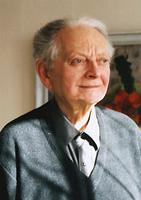
István Anhalt, composer, educator (born at Budapest, Hungary 12 Apr 1919, died at Kingston 24 Feb 2012). One of Canada's most individual composers, whose work is strongly influenced by his study of the psychology of speech, Anhalt combined traditional instruments, electronics and the human voice in the textures and sonorities of a highly complex musical language. He came to Montréal in 1949 and joined McGill's music theory department. He founded and directed its Electronic Music Studio from 1964 to 1971, and then went to Kingston as head of Queen's University music department, where he became professor emeritus in 1984.
Representative of his works are Symphony No. 1 (1958), Symphony of Modules for orchestra and tape (1967), Foci (1969) and La Tourangelle (1975), a musical based on the life of the 17th-century Ursuline MARIE DE L'INCARNATION. His orchestral works Sparkskraps (1988) and Doors-Shadows (Glenn Gould in Memory) (1992) have received several performances. Anhalt continued to compose throughout his life, and wrote the pluri-drama Traces (Tikkan) in 1995 and Millennial Mall, a voice-drama for the imagination, in 1999. He was also well known for his writings, including the books Alternative Voices (1984), Oppenheimer (1990) and A Weave of Life Lines (1992). In 2004 Istvan Anhalt was released in the CD series Canadian Composers Portraits (CMCCD 10204). In 2003, he had been made an Officer of the ORDER OF CANADA and in 2007, he became a Fellow of the ROYAL SOCIETY OF CANADA. His symphonic work The Tents of Abraham won the JUNO award for best classical composition in 2005. Portions of his extensive correspondence with the American composer George Rochberg edited by Alan Gillmor appeared in 2007 (Wilfrid Laurier University Press).

 Share on Facebook
Share on Facebook Share on X
Share on X Share by Email
Share by Email Share on Google Classroom
Share on Google Classroom
